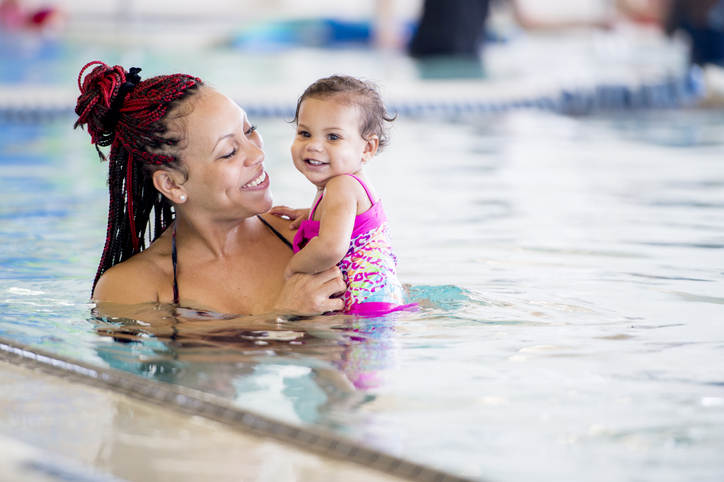Infant water safety is a critical aspect of parenting that demands utmost attention during pool and bath time. While water activities can be enjoyable and beneficial for infants, the risks associated with water-related accidents should not be underestimated. Drowning, accidental ingestion of water, and scalding are some of the potential dangers that infants may encounter when exposed to water, making it imperative for parents to be well-informed about safety measures.

Infant Water Safety Guidelines
When it comes to safeguarding your infant during water-related activities, certain guidelines are of utmost importance. First and foremost, never leave your infant unattended in or near water, be it a bathtub or a pool. Continuous supervision is essential to prevent accidents. Always keep your infant within arm’s reach during bath time and maintain close proximity when they are in or around a pool.
Creating a Safe Environment for Bath Time to Prevent Accidents
Ensure a safe bath time experience for your infant by implementing several important measures. Before placing your baby in the water, check the temperature using your wrist or a bath thermometer to ensure it’s comfortably warm, around 100°F (37.8°C). Fill the tub with just enough water to cover the infant’s legs to minimize the risk of drowning. Additionally, remove any sharp or hazardous objects from the vicinity to avoid accidents.
Recommended Types of Flotation Devices for Infants During Pool Time
When introducing infants to pool time, consider using appropriate flotation devices that provide an added layer of safety. Look for Coast Guard-approved life jackets or floatation vests specifically designed for infants. However, it’s important to remember that these devices are not a substitute for supervision, and you should always maintain close watch over your child.
Dealing with Accidental Ingestion of Pool or Bathwater
Accidental ingestion of pool or bathwater can occur, but it’s crucial not to panic. In most cases, swallowing a small amount of water won’t cause harm. However, if your infant ingests a significant amount or shows signs of distress, contact a healthcare professional immediately for advice.
Childproofing the Pool Area to Prevent Unauthorized Access
Childproofing the pool area is essential to prevent unauthorized access, especially if you have a home pool. Install childproof locks on all gates and doors leading to the pool area, and consider placing a fence around the pool to further restrict access. Additionally, remove any potential hazards or objects that could entice the child to explore the pool area unaccompanied.
Supervision and Awareness
Parents who teach their infants water survival skills and know how to supervise and address infant distress create the safest water environment. Teaching infants essential water survival skills is a proactive approach that enhances their water safety and fosters a sense of confidence in aquatic environments. While it’s crucial to remember that these skills do not make infants drown-proof, they can contribute significantly to their safety. Under professional guidance, parents can introduce infants to techniques like back floating, breath control, and reaching for the pool’s edge. However, it is essential to emphasize that close supervision by an adult is still paramount.
Tips for Supervising Infants During Pool Activities
Effective supervision is crucial when infants engage in pool activities. Designate a responsible adult as the designated water watcher and ensure they remain undistracted during their watch. Maintaining close proximity and constant visual contact with the infant is vital, as infants can get into trouble in water quickly and silently. Avoid using electronic devices or engaging in distracting conversations during pool time to maintain focus on the child’s safety.
Recognizing Signs of Distress or Drowning in Infants During Water Activities
Recognizing distress or drowning signs in infants is crucial for prompt intervention and ensuring their well-being. Infants may not display typical signs of splashing or vocalizing when in distress. Instead, they might appear still with their head low in the water and their mouth at water level. Being aware of these subtle indicators can make a life-saving difference in emergency situations.
Managing Multiple Infants or Children During Pool Time
Supervising multiple infants or children during pool time demands additional vigilance and organization. Assign additional responsible adults or caregivers to help maintain adequate supervision. Implement a buddy system for older siblings, encouraging them to keep watch over each other and younger children. Clear communication of pool safety rules is essential to ensure everyone involved understands their role in maintaining a safe pool environment.
Addressing Infants’ Fear of Water Safely
Addressing infants’ fear of water should be approached with patience and positive reinforcement. Gradual exposure to water and creating a positive association with it during bath time can help build their confidence. Avoid forcing infants into the water if they show signs of fear or discomfort. Instead, allow them to explore water at their own pace and provide encouragement and praise for every small achievement.
Establishing Pool Safety Rules for Parents and Older Siblings
Setting clear and consistent pool safety rules is fundamental for ensuring a safe and enjoyable water experience. Communicate and enforce rules, such as no running around the pool, no diving in shallow areas, and no rough play near infants. Older siblings should be educated about their responsibility in supervising younger children and the significance of safe behavior around water.
Supervision and awareness are key components to creating a secure water environment for infants and making water activities a positive and enjoyable experience while minimizing potential risks.
Bath Time Safety
Proper water temperature, constant supervision, and the use of age-appropriate bathtubs contribute to a positive bathing experience, fostering the bond between parent and child while prioritizing safety
Recommended Water Temperature Guidelines for Bathing Infants
Maintaining the right water temperature is essential for ensuring a safe and comfortable bath time experience for infants. The recommended water temperature is around 100°F (37.8°C). Before placing your baby in the tub, test the water using your wrist or a bath thermometer to ensure it is neither too hot nor too cold. This precautionary measure helps prevent scalding and discomfort during bath time, ensuring a pleasant bathing experience.
Frequency of Checking Water Temperature During Bath Time to Avoid Scalding
To prevent sudden temperature changes and potential scalding incidents, it is crucial to check the water temperature frequently during bath time. Babies have delicate skin, and water temperature can fluctuate rapidly, especially if other hot water sources are being used in the household. Regularly dipping your wrist into the water during the bath allows you to monitor and maintain a safe and comfortable temperature for your little one.
Strategies to Keep Infants Engaged and Entertained During Bath Time
Bath time can be a delightful experience for both parents and infants when creative strategies are employed to keep them engaged and entertained. Bath toys specifically designed for water play can provide enjoyable stimulation for your baby. Gentle splashing and singing can add fun and excitement to the bathing routine. Remember to always maintain direct supervision while engaging in these activities to ensure the safety of your child.
Differences Between Infant Bathtubs and Regular Bathtubs Concerning Safety Features
Infant bathtubs come equipped with safety features tailored to the needs of young children. These may include non-slip surfaces to prevent slips and falls and ergonomic designs that offer comfortable and secure support for the baby. In contrast, regular bathtubs may lack these safety features, requiring parents to exercise additional caution when bathing infants in them. It is essential to prioritize safety and consider using an age-appropriate bathtub to minimize potential risks during bath time.
Pool Time Safety
Determining the appropriate age for supervised pool time for infants is a crucial consideration. While there is no definitive age, most experts suggest waiting until infants are at least six months old before introducing them to pool activities. At this age, babies generally have better head and neck control, making it safer for them to be in the water. However, individual development varies, so it’s essential to consult with a pediatrician before starting pool time.
When initiating pool time, take necessary precautions to ensure the infant’s safety. Begin with short sessions in shallow areas and maintain constant supervision. Use age-appropriate flotation devices like Coast Guard-approved life jackets or floatation vests to add an extra layer of protection. Never leave the infant unattended, and always stay within arm’s reach during pool activities.
Safely Addressing Infants’ Fear of Water During Pool Activities
Some infants may exhibit fear or discomfort when introduced to pool activities. To address this fear safely, adopt a gradual and patient approach. Allow the infant to get acquainted with the water environment at their own pace. Start with gentle water play in a shallow area, using toys and positive reinforcement to create a positive association with water.
Avoid forcing the child into the pool or creating any stressful situations that could exacerbate their fear. Encouragement, praise, and parental support are essential in building the child’s confidence over time. Making pool time a pleasant and enjoyable experience will help them overcome their fear of water gradually.
Pool Safety Rules and Communication with Older Siblings or Family Members
Establishing pool safety rules is paramount to ensure a safe environment for all family members. Communicate these rules clearly to older siblings and other family members who may be present during pool activities. Emphasize the importance of responsible behavior around the pool area and the significance of constant supervision when infants are present.
Ensure that everyone understands their role in maintaining the child’s safety and that the pool area is off-limits when not supervised. Enforce rules like no running around the pool, no diving in shallow areas, and no horseplay near infants. Consistent communication and reinforcement of these rules will help create a safe and responsible pool environment.
Teaching Infants How to Enter and Exit the Pool Safely
Teaching infants how to enter and exit the pool safely is a critical aspect of water safety. Even if they are not actively swimming, knowing how to navigate the pool’s edge is essential in case of accidental falls. Encourage infants to hold onto the pool’s edge with both hands and kick their legs to maintain buoyancy.
To reinforce these skills, practice pool entry and exit with your child under close supervision. Making this a regular part of pool time will help familiarize them with the process and enhance their water safety awareness.
Emergency Preparedness
As responsible parents, being prepared for water-related emergencies is of paramount importance.
CPR and First Aid Techniques for Parents in Case of Water-Related Emergencies During Activities
Learning CPR (Cardiopulmonary Resuscitation) and basic first aid techniques equips parents with life-saving skills that can make a crucial difference in critical situations. In the event of a water-related emergency, prompt and effective response is essential for the infant’s survival and well-being.
To administer CPR to an infant, parents should follow these steps:
1. Check for responsiveness – Tap the infant gently and shout their name to determine if they are conscious.
2. Call for help – If the infant is unresponsive, immediately call for emergency medical assistance.
3. Open the airway – Carefully tilt the baby’s head back to open their airway while supporting their neck and chin.
4. Give rescue breaths – Cover the infant’s mouth and nose with your mouth and provide two gentle breaths. Watch for their chest to rise with each breath.
5. Perform chest compressions – Place two fingers on the center of the infant’s chest, just below the nipple line, and deliver 30 quick compressions at a depth of about 1.5 inches.
6. Continue cycles – Perform two rescue breaths followed by 30 compressions until help arrives or the infant starts breathing on their own.
Additionally, knowing basic first aid techniques for addressing common water-related injuries can prove invaluable. Being prepared to handle situations such as minor cuts, abrasions, or head injuries can help stabilize the situation until medical professionals can provide further assistance.
These essential emergency preparedness skills, allows parents to significantly enhance their ability to respond effectively in water-related emergencies, ensuring the safety and well-being of their infants during water activities.
Links to Additional Resources or Courses for Learning More about Infant Water Safety
For parents seeking further knowledge and expertise in infant water safety, several resources and courses are available. Websites like the American Red Cross, Safe Kids Worldwide, and the National Drowning Prevention Alliance offer valuable information and educational materials on water safety practices. Local community centers and swimming schools may also offer infant water safety classes, which can provide hands-on training and insights from experienced instructors. Investing time and effort in acquiring additional knowledge and skills can further enhance parents’ ability to ensure their infants’ safety during pool and bath time.
Prioritizing infant water safety and incorporating the guidelines and best practices discussed in this article, helps parents create a secure and enjoyable water environment for their infants. Remember, fostering a safe and positive water experience early on can lay the foundation for a lifetime of aquatic enjoyment while minimizing potential risks.
Conclusion
Ensuring the safety of infants during pool and bath time is of utmost importance. Water-related accidents can happen quickly and silently, making it crucial for parents to be vigilant and proactive in safeguarding their little ones. As parents, taking proactive steps to implement the guidelines and best practices outlined in this article is a critical responsibility. Staying informed and educated about infant water safety, enhances parents’ ability to protect their children during water-related activities. Regularly practicing close supervision, childproofing pool areas, using appropriate flotation devices, and addressing infants’ fear of water with patience and support can contribute to a positive and safe water experience for both parents and infants.




